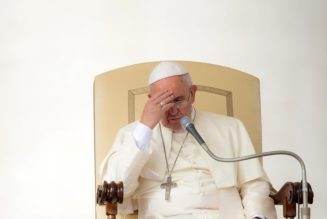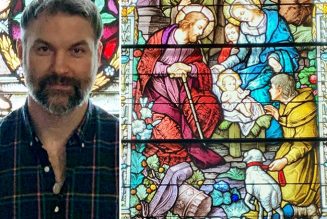By Dr. Jeff Mirus ( bio – articles – email ) | Dec 02, 2021
The interior makeover of the Cathedral of Notre-Dame in Paris presents us with some very disturbing questions. Everybody will remember the fire in April of 2019 which severely damaged one of the best-known churches in Christendom, and the outpouring of gifts from rich and famous people around the world to aid in its restoration. The restoration of the exterior is proceeding under the authority of the French Ministry of Culture; but the interior renovations are in the hands of the Archdiocese of Paris. (Such are the vagaries of life in the modern nation state.)
It may (or may not) be relevant that the resignation of the Archbishop of Paris has just been accepted by Pope Francis because of an improper relationship with a woman—which first became known nearly ten years ago. In any case, he has been in charge of this Notre-Dame renovation, and for reasons made clear in a recent report from the Catholic News Agency (see our linked story, Paris archdiocese to present plans for Notre-Dame’s interior amid outcry), many have raised serious questions about what appears to be a depressingly secular plan of interior renewal. The plan calls for “the removal of confessional boxes, altars, and classical sculptures”, to be replaced with “modern art murals, and new sound and light effects to create ‘emotional spaces’.”
Opinions vary, of course, but there is a good deal of concern that the interior renovation is headed toward secular kitsch or, as one critic has suggested, a “politically correct Disneyland”. Perhaps fortunately in this case, the plan must be approved by the French Ministry of Culture.
Seven gifts, seven sins, seven dangers
You’ve heard of the seven gifts of the Holy Spirit, and you’ve also heard of the seven capital sins. Here I am going to suggest seven distinctions that must be thoroughly grasped by Catholics, both for Church design and for life.
1. Art vs. Illusion
The more we “design” and “decorate” with electronic effects like recorded music and artificial light, the more we remove a space from its real, concrete relationship with God and change that space into a human counterfeit. While this may be perfectly fine in certain kinds of entertainment, it is disastrous in the service of God, who is essentially transcendent, who invites us to use our surroundings as an aid to approaching and even contemplating Him. Natural materials such as stone and wood, shaped artistically in forms that are traditional within a given culture, root us in what is lasting, as we contemplate the God who transcends even the most beautiful use of the gifts He has given us. What is real and lasting points us to the infinite and eternal source of all. Obtrusive technology, ever changing in its application, teases us with an artificial experience, which is as immanent as it is unreal. This may be suited to entertainment. It is not suited to either worship or self-examination before God.
2. Local vs. Global
The Catholic Church may be universal, but her universality is always expressed through the particular. Moreover, the Church may be global, but that does not even begin to exhaust her universality. A design effort to make a church “global” actually diminishes the connection between the particular and the universal. As finite beings we are not capable of expressing universality other than through our own “particular”. The effort to do so leads either to the banal or the vacuous. We either trivialize or express nothing. Just as the Church is universal at once because she is of God and because she values every people and place and culture, every particularity, so too is Catholicism, even more than politics, always local. The attempt to “artistically remove” a church’s particularity by extending its design to what we might call particulars foreign to its human provenance (whether of modern art in a medieval church or African themes in a European church) is precisely a failure to recognize the genius of the Church’s universal localism. A beautiful church does not achieve the universal by pointing deliberately to a wide range of detached particulars, as in the current plan, but by orienting the real particulars of its own origins toward God—that is, by giving glory through the profound relevance of its own localism.
3. Worship vs. Social Messaging
We find the very same dangers in the preference for fostering human attitudes over authentic worship. Overt “social messaging” has little or no place in Church design, just as it has little or no place in Divine liturgy: Sometimes in a homily, of course, but even in the prayers of the faithful we should be dealing with heartfelt prayer, not “social messaging” (though this principle is often abused). A Catholic social outlook, if it is to have any life beyond the latest cultural fads, must be rooted in our own worship of God and incorporation into Christ. Sadly, social messaging (as seems to be envisioned in the new “politically correct” interior design for the cathedral in question here) puts the cart way ahead of the horse. We can “go out” to others only insofar as we are first grafted into the one body of Christ. The horizontal dimension emanates from the vertical dimension as a living fire, or else it sputters and dies. Church design must focus on lifting the mind, heart and soul to God. This alone has staying power; this alone converts.
4. Sacramental vs. Psychological
Sound spirituality is good psychology. In true religion, the sacramental always precedes and accompanies the psychological. But in the new design, does the pattern of contemporary secular “influencing” (psychological manipulation) take precedence over sacramental initiation and the resultant Divine nourishment and inspiration? This question must arise when confessionals and side altars are being replaced by light-and-sound shows. I grant that ecclesiastical life is different now than in Notre-Dame’s halcyon days. The eras of Mass priests (less educated clergy ordained purely for the purpose of offering stipend/bequest masses on a large scale) and frequent confessions may be long past (though they may be past only like the once and future king). Perhaps one might make confessionals and side altars fewer and larger. But this question brings the United States’ own national basilica to mind. The Basilica of the National Shrine of the Immaculate Conception in Washington, DC offers a lesson through its large number of side altars, which represent the actual contributions of different peoples, cultures and pieties to the building of the Basilica, and are in themselves far more conducive to union with God than “emotional spaces”.
5. Rooted vs. Instant
I have already touched on the sense of rootedness which goes with the use of particular natural materials, but there is also a permanence about “rootedness” which contrasts with all that is “instant”, especially at a time when a constantly changing pattern of instant gratification is one of the most prevalent (and least fortunate) influences in modern culture. Paradoxically, one of the drawbacks of design through light and sound is that it is instantly configurable, instantly changeable. Nothing could be more disastrous in the design of churches. This radically diminishes the building’s formative influence: If we don’t like it next week, we can change it. In contrast, entry into a Church should be entry into a space which reminds us of the essential permanence of the sacred realities which it serves. Instant configurability sends exactly the wrong spiritual message.
6. Depth vs. Superficiality
Most of the previous headings impinge, in one way or another, on this one: Should the architecture and art of a church—that is, its structural, exterior, and interior design—suggest a deep mystery or a superficial message? The more a church is oriented by design to the affairs and fads of this world—as is the case if it has a built-in system for instantly changeable moods and messages—the less it disposes those who enter to that reflection on the permanent things which expresses itself, finally, in worship and conversion of heart. A church is not a theater. Within living memory we have survived a period of congregational enlightenment through a constant succession of decorative banners, and if this did not teach us a lesson, perhaps nothing human ever can. But the profusion of infantile banners really did teach a lesson, if only negatively: “This is what superficial looks like.” However bright, flowery and smiley, the slogan du jour is not effective: To change hearts, we must go deeper, and foster prayer.
7. God vs. the World
Ultimately we must always distinguish the object of our concern from the object of our hope. Any ecclesiastical space which emphasizes the need for action on our worldly concerns at the expense of the need to place all our trust in Jesus Christ—or any design which seeks to focus our attention on those things which lie outside the building but do not transcend it—any such church fosters a hopeless scurrying for “human improvement”. Genuine trust in and reliance on God always increases charity and multiplies good in this world. But a shift in primary focus to material human needs fosters pride in our own powers, or avoidance, or burnout, or even despair. Without God at the center, we are reduced to fashionable causes (often harmful) or a frank absorption in ideas of happiness arising from the world, the flesh and the Devil. A church, through its design and decoration, must point not out but up: “In the world you have tribulation; but be of good cheer, I have overcome the world” (Jn 33:16).
Conclusion
Every church must be constructed on the principle that it is not we who save, but only Christ. Each Catholic church is God’s house. It is designed to signal not only the reality but the very presence of God. It is built only so that we may find Him there. And from that finding, every other good thing flows.
“Behold,” says our Lord and Savior, “I make all things new” (Rev 21:5). This is the testimony of each church, and without that testimony, we cannot even begin to stop the trouble we see all around us any more than we can stem the tide of trouble within our own hearts. For without Him, everything on earth does what is in its nature to do: If non-living, it degrades; if living, it grows weak or old, and then it dies.
Sound Off! CatholicCulture.org supporters weigh in.
All comments are moderated. To lighten our editing burden, only current donors are allowed to Sound Off. If you are a current donor, log in to see the comment form; otherwise please support our work, and Sound Off!

Join Our Telegram Group : Salvation & Prosperity










